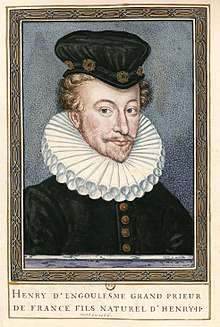Henri d'Angoulême
Henri de Valois, duc d'Angoulême (1551 in Aix-la-Chapelle – 2 June 1586 in Aix-en-Provence), sometimes called "Henri, bâtard de Valois" or "Henri de France", was a Légitimé de France, cleric, and military commander during the Wars of Religion.
| Henri | |||||
|---|---|---|---|---|---|
| Duke of Angoulême | |||||
 Portrait engraving of Henri d'Angoulême | |||||
| Born | 1551 Aix-la-Chapelle, Rhineland, Holy Roman Empire | ||||
| Died | 2 June 1586 (aged 34-35) Aix-en-Provence, France | ||||
| |||||
| House | Valois-Angoulême | ||||
| Father | Henri II of France | ||||
| Mother | Janet Stewart | ||||
| Religion | Roman Catholicism | ||||
Biography
Henri de Valois was born the bastard son of Henri II of France and his mistress Janet Stewart, who was an illegitimate daughter of James IV of Scotland and served as governess to the young Mary, Queen of Scots.[1] Being the most highly favored natural son of the King, Henri was legitimized and made Duke of Angoulême. He would later serve as Abbot of La Chaise-Dieu, Grand Prior of France[2] and Admiral of the Levantine Sea, further ruling as Governor of Provence from 1579 until his death in 1586.
In 1570, the supporters of Mary, Queen of Scots, who was exiled in England, selected Henri as a potential leader of a French military force to aid them in their civil war against the supporters James VI of Scotland. They thought that Henri's Scottish and French royal ancestry would gain him respect in Scotland and England. Although the Queen's supporters put the idea to John Lesley, Queen Mary's ambassador in France, French soldiers and Henri were not sent to Scotland.[3]

Henri d'Angoulême took a major role in the two extended military battle against Huguenot strongholds during the height of the French Wars of Religion, engaging in the massive Siege of La Rochelle (1572–1573), organized by the Duke of Anjou, future Henry III of France, and leading the five-year Siege of Ménerbes (1573–1578), fought at a citadel in the Luberon foothills cherished by Pope Pius V.
While serving as Governor of Provence, his secretary was the poet François de Malherbe.[4] Henri wrote many sonnets, one of which was set to music by Fabrice Caietain.[2]
In 1586, Henri was killed at Aix-en-Provence in a duel with Philip Altoviti, who also was mortally wounded in the fight.[5]
Ancestry
| Ancestors of Henri d'Angoulême | ||||||||||||||||||||||||||||||||||||||||||||||||||||||||||||||||||||||||||||||||||||||||||||||||||||||||||||||||||||||||||||||||||||||||||||||||||||||||||||||||||||||||||||||||||||||||||||||||||||||||||||||||||||||||||||||||||||||||||||||||||||||||||||||||||||||||||||||||||||||||||||||||||||||||||||||||||||||||||||||||||||||||||||||||||||||||||||||||||||||||||||||||||||||||||||||||||||||||||||||||||||||||||||||||||||||||||||||||||||||||||||||||||||||||||||||||||||||||||||||||||||||||||||||||||||||||||||||||||||||||||||||||||||||||||||||||||||||||||||||||||||||||||||||||
|---|---|---|---|---|---|---|---|---|---|---|---|---|---|---|---|---|---|---|---|---|---|---|---|---|---|---|---|---|---|---|---|---|---|---|---|---|---|---|---|---|---|---|---|---|---|---|---|---|---|---|---|---|---|---|---|---|---|---|---|---|---|---|---|---|---|---|---|---|---|---|---|---|---|---|---|---|---|---|---|---|---|---|---|---|---|---|---|---|---|---|---|---|---|---|---|---|---|---|---|---|---|---|---|---|---|---|---|---|---|---|---|---|---|---|---|---|---|---|---|---|---|---|---|---|---|---|---|---|---|---|---|---|---|---|---|---|---|---|---|---|---|---|---|---|---|---|---|---|---|---|---|---|---|---|---|---|---|---|---|---|---|---|---|---|---|---|---|---|---|---|---|---|---|---|---|---|---|---|---|---|---|---|---|---|---|---|---|---|---|---|---|---|---|---|---|---|---|---|---|---|---|---|---|---|---|---|---|---|---|---|---|---|---|---|---|---|---|---|---|---|---|---|---|---|---|---|---|---|---|---|---|---|---|---|---|---|---|---|---|---|---|---|---|---|---|---|---|---|---|---|---|---|---|---|---|---|---|---|---|---|---|---|---|---|---|---|---|---|---|---|---|---|---|---|---|---|---|---|---|---|---|---|---|---|---|---|---|---|---|---|---|---|---|---|---|---|---|---|---|---|---|---|---|---|---|---|---|---|---|---|---|---|---|---|---|---|---|---|---|---|---|---|---|---|---|---|---|---|---|---|---|---|---|---|---|---|---|---|---|---|---|---|---|---|---|---|---|---|---|---|---|---|---|---|---|---|---|---|---|---|---|---|---|---|---|---|---|---|---|---|---|---|---|---|---|---|---|---|---|---|---|---|---|---|---|---|---|---|---|---|---|---|---|---|---|---|---|---|---|---|---|---|---|---|---|---|---|---|---|---|---|---|---|---|---|---|---|---|---|---|---|---|---|---|---|---|---|---|---|---|---|---|---|---|---|---|---|---|---|---|---|---|---|---|---|---|---|---|---|---|---|---|---|---|---|---|---|---|---|---|---|---|---|---|---|---|---|---|---|---|---|---|---|---|---|---|---|---|---|---|---|---|---|---|---|---|---|---|---|---|---|---|---|---|---|---|---|---|---|---|---|---|---|---|---|---|---|---|---|---|---|---|---|---|---|---|---|---|---|---|---|---|---|---|---|---|---|---|---|---|---|---|---|---|---|---|---|---|---|---|---|---|---|---|---|---|---|---|---|---|---|---|---|---|---|---|---|---|---|---|---|---|---|---|---|---|---|---|---|---|---|---|---|---|---|---|
| ||||||||||||||||||||||||||||||||||||||||||||||||||||||||||||||||||||||||||||||||||||||||||||||||||||||||||||||||||||||||||||||||||||||||||||||||||||||||||||||||||||||||||||||||||||||||||||||||||||||||||||||||||||||||||||||||||||||||||||||||||||||||||||||||||||||||||||||||||||||||||||||||||||||||||||||||||||||||||||||||||||||||||||||||||||||||||||||||||||||||||||||||||||||||||||||||||||||||||||||||||||||||||||||||||||||||||||||||||||||||||||||||||||||||||||||||||||||||||||||||||||||||||||||||||||||||||||||||||||||||||||||||||||||||||||||||||||||||||||||||||||||||||||||||
References
- Sealy 1981, p. 206.
- Brooks 2000, p. 124.
- Cameron 1931, p. 85-86.
- Joseph & Green 2004, p. 112.
- Kelly 1913, p. 569.
Sources
- Brooks, Jeanice (2000). Courtly song in late sixteenth-century France. The University of Chicago Press.CS1 maint: ref=harv (link)
- Cameron, Annie, ed. (1931). Warrender Papers. vol.1. T. and A. Constable Ltd.CS1 maint: ref=harv (link)
- Joseph, George; Green, Maria (2004). Rubin, David Lee (ed.). La Poésie Française du Premier 17e siècle: Textes et Contextes: "François Malherbe" (in French). Rookwood Press, Inc.CS1 maint: ref=harv (link)
- Kelly, Blanche M. (1913). "Francois Malherbe". In Herbermann, Charles George; Pace, Edward Aloysius (eds.). The Catholic Encyclopedia. Vol. 9. The Encyclopedia Press, Inc.CS1 maint: ref=harv (link)
- Sealy, Robert J. (1981). The Palace Academy of Henry III. Droz.CS1 maint: ref=harv (link)